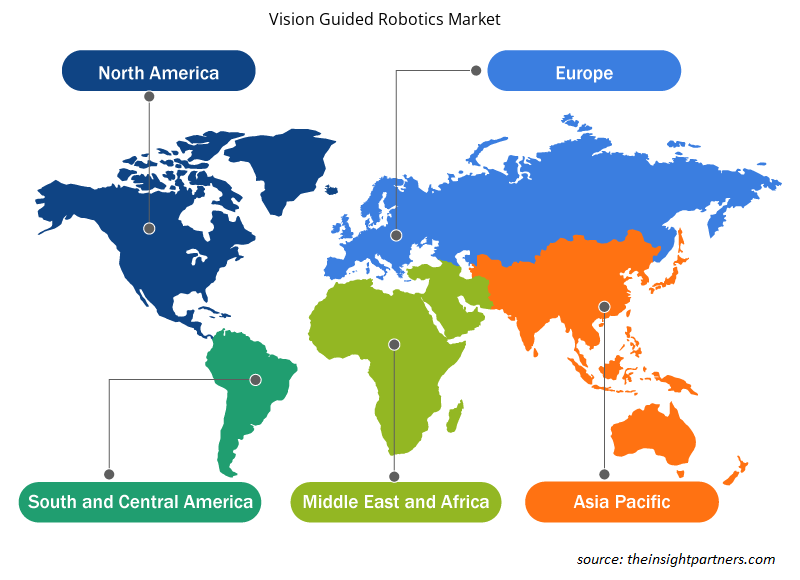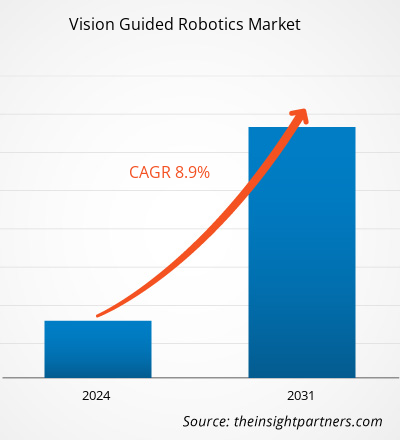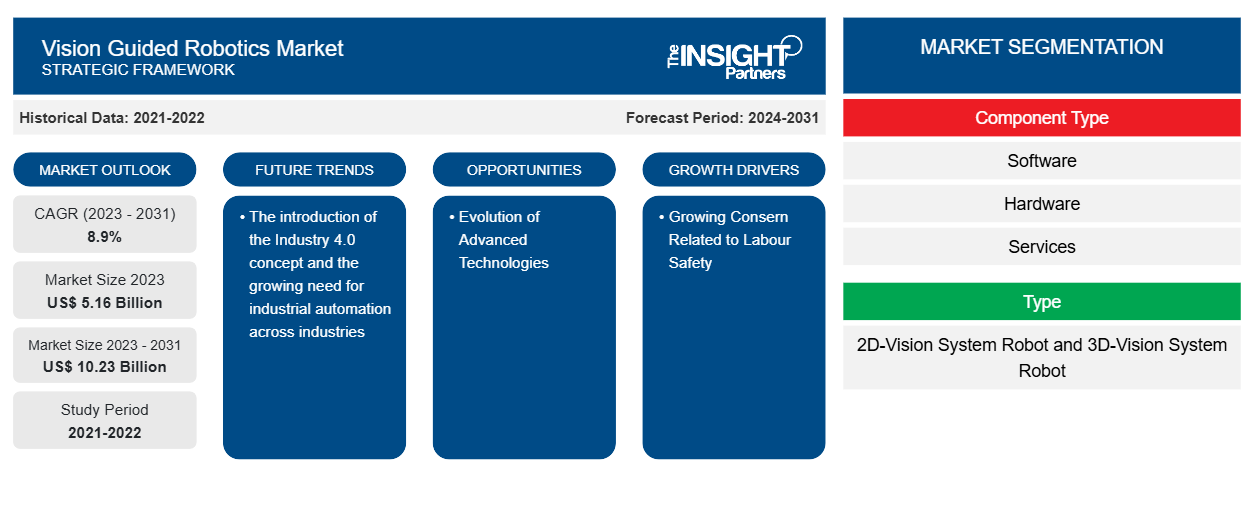Si prevede che la dimensione del mercato della robotica guidata dalla visione raggiungerà i 10,23 miliardi di dollari entro il 2031, rispetto ai 5,16 miliardi di dollari del 2023. Si prevede che il mercato registrerà un CAGR dell'8,9% nel 2023-2031. L'introduzione del concetto di Industria 4.0 e la crescente necessità di automazione industriale in tutti i settori rimarranno probabilmente una tendenza chiave del mercato della robotica guidata dalla visione.
Analisi di mercato della robotica guidata dalla visione
Il mercato della robotica guidata dalla visione sta crescendo a un ritmo rapido a causa della crescente preoccupazione relativa alla sicurezza sul lavoro, della crescente domanda di ispezione e controllo della qualità tra i settori e della crescente adozione della robotica guidata dalla visione nelle PMI. Il mercato si sta espandendo costantemente, guidato dal crescente utilizzo di robot collaborativi in contesti di produzione collaborativa. Inoltre, l'evoluzione delle tecnologie avanzate e gli sviluppi nella tecnologia della visione artificiale stanno offrendo opportunità redditizie per la crescita del mercato.
Panoramica del mercato della robotica guidata dalla visione
La robotica guidata dalla visione è un sistema robotico che impiega algoritmi di visione artificiale e telecamere per consentire ai robot di svolgere attività che richiedono percezione e interpretazione visiva. L'idea principale alla base della robotica guidata dalla visione è quella di dare ai robot la capacità di vedere e comprendere l'ambiente circostante, consentendo loro di navigare, interagire con le cose ed eseguire attività in modo più accurato ed efficiente. I robot guidati dalla visione utilizzano spesso telecamere ad alta risoluzione, elaborazione delle immagini moderna e algoritmi di apprendimento automatico per valutare i dati visivi ed esprimere giudizi basati su di essi. La robotica guidata dalla visione è comunemente utilizzata per attività di pick-and-place, assemblaggio e ispezione, imballaggio e controllo qualità. La crescente adozione della robotica guidata dalla visione in numerosi settori, come automotive, aerospaziale e difesa, cibo e bevande, elettrico ed elettronico, sanitario e farmaceutico, lavorazione dei metalli e altri, sta guidando il mercato.
Personalizza questo report in base alle tue esigenze
Riceverai la personalizzazione gratuita di qualsiasi report, comprese parti di questo report, o analisi a livello nazionale, pacchetto dati Excel, oltre a usufruire di grandi offerte e sconti per start-up e università
-
Scopri le principali tendenze di mercato in questo rapporto.Questo campione GRATUITO includerà analisi di dati che spaziano dalle tendenze di mercato alle stime e alle previsioni.
Driver e opportunità del mercato della robotica guidata dalla visione
La crescente preoccupazione per la sicurezza sul lavoro sta guidando il mercato
Poiché i requisiti internazionali sulla sicurezza del lavoro diventano più severi, le industrie di tutto il mondo stanno spostando la loro preferenza verso l'adozione di robot sostituendo i lavoratori umani nelle aree pericolose. I robot possono svolgere compiti dannosi e non sicuri per gli esseri umani, il che aumenta la loro domanda in aree pericolose, tra cui operare in terreni difficili e gestire sostanze pericolose. Le industrie possono ridurre i rischi e il numero di incidenti sul lavoro utilizzando robot in determinati ambienti rischiosi sta alimentando il mercato della robotica guidata dalla visione durante il periodo di previsione.
Evoluzione delle tecnologie avanzate: un’opportunità nel mercato della robotica guidata dalla visione
L'introduzione di nuove tecnologie ha portato allo sviluppo di una robotica più efficace ed efficiente sul mercato. Questi robot tecnologicamente avanzati possono svolgere compiti con maggiore accuratezza e precisione, il che comporta costi inferiori. Quindi, creando opportunità di crescita del mercato durante il periodo di previsione.
I progressi tecnologici hanno reso i sistemi robotici più compatti e modulari, dando vita a robot di qualità superiore e più versatili. Il crescente utilizzo di robot aumentati e modulari sta generando significative opportunità di crescita per il mercato nel prossimo futuro.
Analisi della segmentazione del rapporto di mercato sulla robotica guidata dalla visione
I segmenti chiave che hanno contribuito alla derivazione dell'analisi di mercato della robotica guidata dalla visione sono il tipo di componente, la tipologia e il settore verticale.
- In base al tipo di componente, il mercato della robotica guidata dalla visione è suddiviso in software, hardware e servizi. Il segmento hardware ha detenuto una quota di mercato maggiore nel 2023.
- In base al tipo, il mercato è segmentato in robot con sistema di visione 2D e robot con sistema di visione 3D. Il segmento dei robot con sistema di visione 3D ha detenuto una quota di mercato maggiore nel 2023.
- In termini di settore verticale, il mercato è categorizzato come automotive, aerospaziale e difesa, food & beverage, healthcare e farmaceutica, elettrico ed elettronico, lavorazione dei metalli e altri. Il segmento automotive ha detenuto una quota di mercato maggiore nel 2023.
Analisi della quota di mercato della robotica guidata dalla visione per area geografica
L'ambito geografico del rapporto sul mercato della robotica guidata dalla visione è suddiviso principalmente in cinque regioni: Nord America, Asia Pacifico, Europa, Medio Oriente e Africa e Sud America/Sud e Centro America.
In termini di fatturato, l'Asia Pacifica ha rappresentato la quota di mercato più grande della robotica guidata dalla visione, grazie alle tecnologie emergenti e all'elevato volume di capacità produttive. Inoltre, si prevede che la crescente implementazione del concetto di Industria 4.0 e l'aumento degli investimenti da parte delle aziende per l'istituzione di strutture produttive alimenteranno la domanda per tutto il periodo di proiezione.
Notizie di mercato e sviluppi recenti della robotica guidata dalla visione
Il mercato della robotica guidata dalla visione viene valutato raccogliendo dati qualitativi e quantitativi post-ricerca primaria e secondaria, che includono importanti pubblicazioni aziendali, dati di associazioni e database. Di seguito è riportato un elenco degli sviluppi nel mercato della robotica guidata dalla visione e delle strategie:
- A marzo 2023, Smart Vision Lights co-sponsorizza il webinar di Quality Magazine che esamina la recente evoluzione della robotica guidata dalla visione e aiuta a guidare le aziende alla ricerca di nuove soluzioni di automazione. Il webinar sarà utile a tutti gli interessati alla tecnologia della robotica guidata dalla visione, tra cui gestione aziendale, della qualità e degli impianti, ingegneria e operazioni, indipendentemente dal mercato. (Fonte: Smart Vision Lights, comunicato stampa, 2023)
Copertura e risultati del rapporto di mercato sulla robotica guidata dalla visione
Il rapporto "Dimensioni e previsioni del mercato della robotica guidata dalla visione (2023-2031)" fornisce un'analisi dettagliata del mercato che copre le seguenti aree:
- Dimensioni e previsioni del mercato a livello globale, regionale e nazionale per tutti i segmenti di mercato chiave coperti dall'ambito
- Dinamiche di mercato come fattori trainanti, vincoli e opportunità chiave
- Principali tendenze future
- Analisi dettagliata delle cinque forze PEST/Porter e SWOT
- Analisi di mercato globale e regionale che copre le principali tendenze di mercato, i principali attori, le normative e gli sviluppi recenti del mercato
- Analisi del panorama industriale e della concorrenza che copre la concentrazione del mercato, l'analisi della mappa di calore, i principali attori e gli sviluppi recenti
- Profili aziendali dettagliati
Ambito del rapporto
Vision Guided Robotics Market Regional Insights
Le tendenze regionali e i fattori che influenzano il mercato della robotica guidata dalla visione durante il periodo di previsione sono stati ampiamente spiegati dagli analisti di Insight Partners. Questa sezione discute anche i segmenti e la geografia del mercato della robotica guidata dalla visione in Nord America, Europa, Asia Pacifico, Medio Oriente e Africa e America meridionale e centrale.

- Ottieni i dati specifici regionali per il mercato della robotica guidata dalla visione
Ambito del rapporto di mercato sulla robotica guidata dalla visione
| Attributo del report | Dettagli |
|---|---|
| Dimensioni del mercato nel 2023 | 5,16 miliardi di dollari USA |
| Dimensioni del mercato entro il 2031 | 10,23 miliardi di dollari USA |
| CAGR globale (2023-2031) | 8,9% |
| Dati storici | 2021-2022 |
| Periodo di previsione | 2024-2031 |
| Segmenti coperti |
Per tipo di componente
|
| Regioni e Paesi coperti |
America del Nord
|
| Leader di mercato e profili aziendali chiave |
|
Densità dei player del mercato della robotica guidata dalla visione: comprendere il suo impatto sulle dinamiche aziendali
Il mercato della Vision Guided Robotics Market sta crescendo rapidamente, spinto dalla crescente domanda degli utenti finali dovuta a fattori quali l'evoluzione delle preferenze dei consumatori, i progressi tecnologici e una maggiore consapevolezza dei vantaggi del prodotto. Con l'aumento della domanda, le aziende stanno ampliando le loro offerte, innovando per soddisfare le esigenze dei consumatori e capitalizzando sulle tendenze emergenti, il che alimenta ulteriormente la crescita del mercato.
La densità degli operatori di mercato si riferisce alla distribuzione di aziende o società che operano in un particolare mercato o settore. Indica quanti concorrenti (operatori di mercato) sono presenti in un dato spazio di mercato in relazione alle sue dimensioni o al valore di mercato totale.
Le principali aziende che operano nel mercato della robotica guidata dalla visione sono:
- ABB Ltd.
- Basilea AG
- Cognex
- Società Denso
- Società Fanuc
- Visione ISRA
Disclaimer : le aziende elencate sopra non sono classificate secondo un ordine particolare.

- Ottieni una panoramica dei principali attori del mercato della robotica guidata dalla visione
- Analisi storica (2 anni), anno base, previsione (7 anni) con CAGR
- Analisi PEST e SWOT
- Valore/volume delle dimensioni del mercato - Globale, Regionale, Nazionale
- Industria e panorama competitivo
- Set di dati Excel
Report recenti
Testimonianze
Motivo dell'acquisto
- Processo decisionale informato
- Comprensione delle dinamiche di mercato
- Analisi competitiva
- Analisi dei clienti
- Previsioni di mercato
- Mitigazione del rischio
- Pianificazione strategica
- Giustificazione degli investimenti
- Identificazione dei mercati emergenti
- Miglioramento delle strategie di marketing
- Aumento dell'efficienza operativa
- Allineamento alle tendenze normative























 Ottieni un campione gratuito per - Mercato della robotica guidata dalla visione
Ottieni un campione gratuito per - Mercato della robotica guidata dalla visione